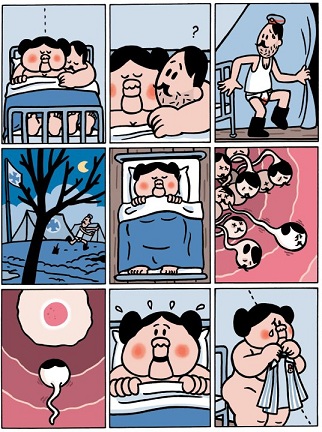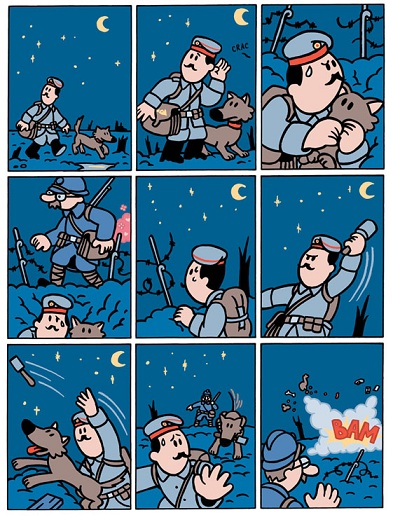
Translate this is an occasional series about European comics that need to be translated into English, inspired by Grant Goggins’ old Reprint This blog. Last time around it was Bernard Prince, this time it’s Boerke: De Zoon Van.
Boerke has actually been translated before; two volumes of Dickie have been published by Bries. However the Dutch language series runs to seven albums in total, of which De Zoon Van is the sixth. Translating the series shouldn’t be the hardest of jobs; the strips are mostly textless. Silent comics are perhaps the purest form of comics and Pieter de Poortere is very good at them. He manages to put a lot of character and emotion in his Playmobil like characters.
Whereas the first five or so albums are largely one page gag strips, this one is a complete story, the first longer story Pieter de Poortere has attempted for Boerke. As you might deduce from the cover, left, the story revolves around a certain German Chaplin moustache wearing dictator. Or rather, his son. Because it turns out that at the end of the First World War Hitler got slightly too friendly with a Flemish peasant woman and got himself a bastard son he never knew about: Boerke.

Boerke has to deal with all the little problems living in occupied Belgium in the Second world War brings with it: being mistaken for a collaborator, hiding a Jewish refugee and later an American airman, handing them over to the nazis when they fall in love and he gets jealous, try to commit suicide only to be almost hanged by the resistance, escaping, being mistaken for a jew and shipped to Auschwitz, that sort of thing.
Meanwhile in Berlin things are not going well either as Eva wants a child but Adolf, well, can’t get it up. She then tells him of the existence of his son, he goes to get him, some more adventures later they are united for the first time and the reich has a new slogan: Ein Reich, Ein Volk, Zwei Fuhrers…
There’s a strange sort of innocence about Boerke, helped by the simple, almost childlike artwork of de Poortere. The humour is black, but not cynical, if that makes any sense. The artwork is simplified but great, especially in the two page Where’s Wally spreads that intersperse the story.

No Comments